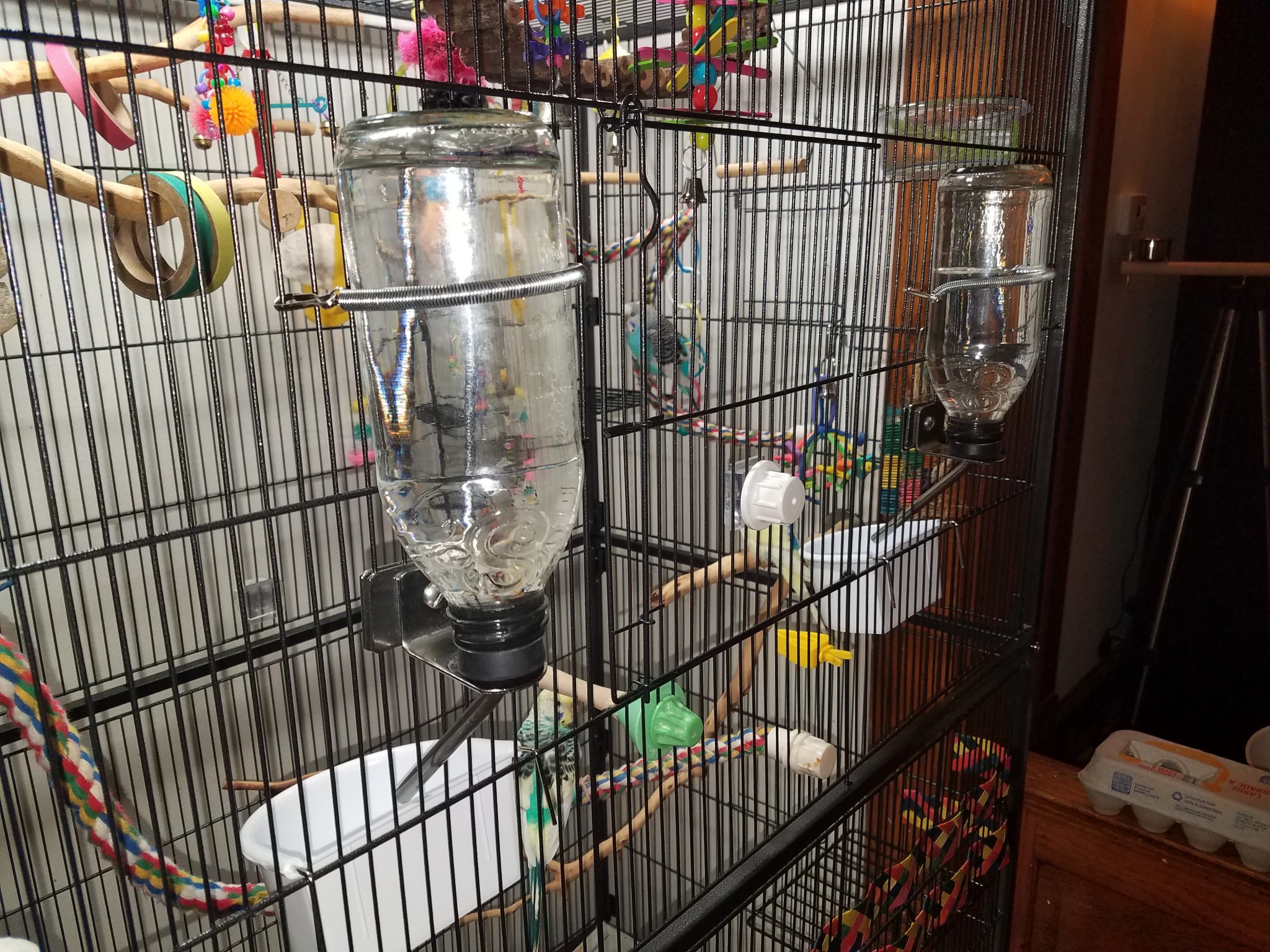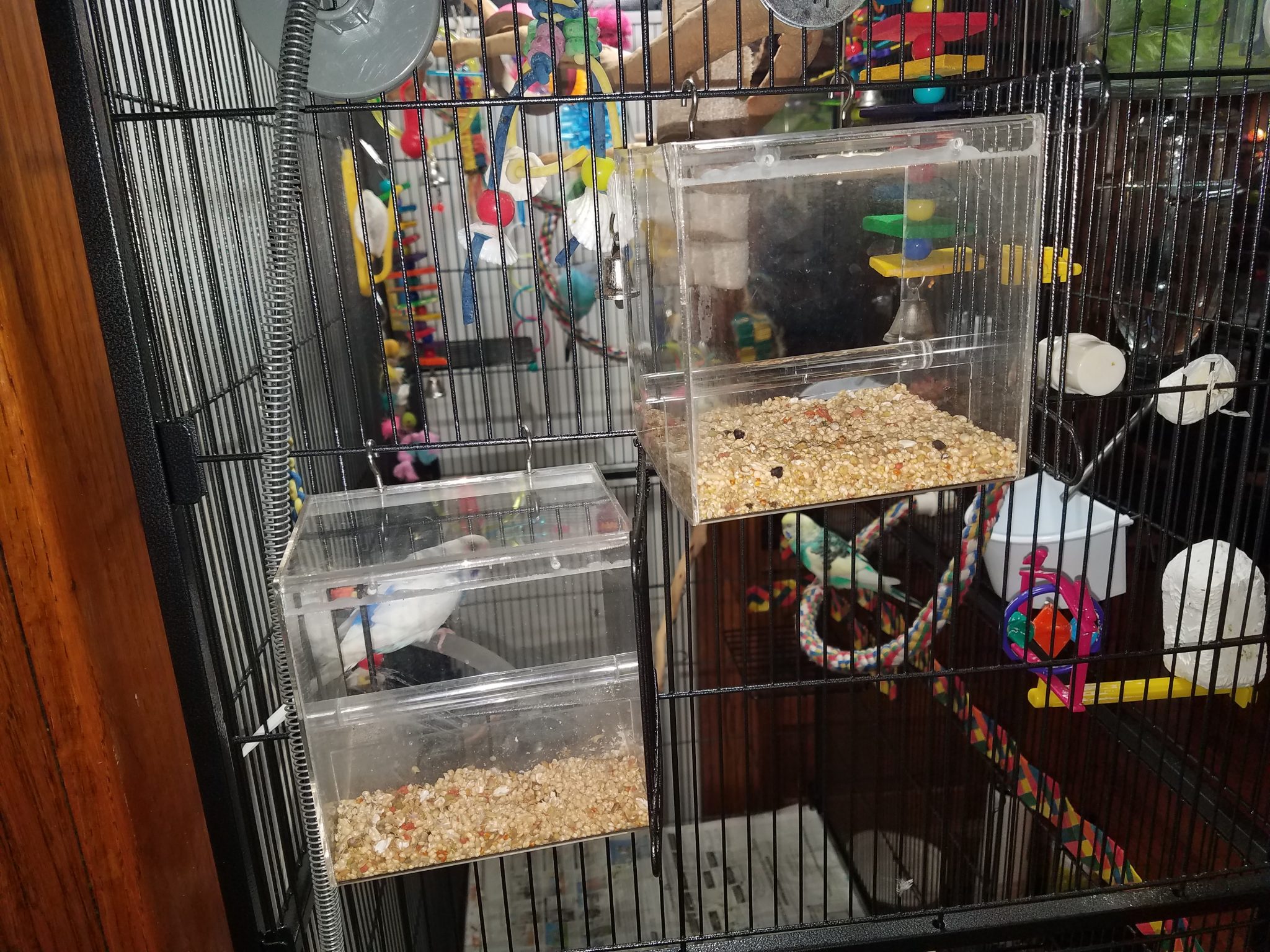Last Updated on by Catherine Tobsing
I’ve often said the universe is too complex to be arbitrary.
We brought home a Prevue F040 birdcage for our six budgies, but once built we clearly felt it was too small.
It sat in our living room for about three weeks.
During that time we received a phone call and long story short we ended up rescuing a 17-year-old male African ringneck.
In that he was brought home in a wire cage we felt the cage that was too small for six budgies would be fine for a single ringneck – we were right.
In the meantime, we upped our game to a much larger cage the Prevue F050 37 inches wide and 22 inches front to back if memory serves me right.
There are three stages to creating an in-cage environment for your pet bird(s).
- Assemble the cage
- Fill the cage with toys and accessories
- Add the bird(s)
That process took us roughly 3 1/2 days.
I got a little turned around because I thought the F050 would be assembled identically to the F040 but was mistaken.
Due to its size there are two additional, I’m calling them “stabilizer bars”. Also the top and the bottom side panels that a slightly different height in the F050 whereas all four panels are the same height on the F040.
I didn’t pay attention to the time but the entire process took 1 to 2 hours for either cage including un-boxing.
In the case of our new budgie aviary, Catherine started adding internal components over a period of two days.
We currently have six budgies but there are two waiting in quarantine at a rescue awaiting retrieval by us.
When you have multiple birds in a cage is important to have multiple sources of food and water.
Jealousies can arise and a single food dish can be blocked by a jealous bird.
We keep two Hagen hook-on dishes underneath the nozzles in an effort to teach the birds they can access water through the tip of the dish.
We offer lettuce baths almost daily in Smart Crock dishes on the far left and right of the cage.
We found a couple of old Tidy Seed mess-less food dispensers which we added.
Prevue had the foresight to provide four swing-out doors on both the left and the white sides of the cage.
Usually, you just get one in case you want to hang a nest box but in this case the spring-loaded doors are quite useful for adding and removing food toys and accessories without having to reach through a large aviary.
Budgies are naturally ground feeders so we always offer at least two small or one large dish filled with seed on the bottom of the cage.
It’s how budgies eat naturally in the wild.
Catherine centered her entire cagescaping design around two large (long) manzanita perches top left and horizontal middle of the cage and then added soft rope Booda perches, a Wonder Walk Ladder across the inside top, at least a bird dozen toys and a few more perches to boot.
Not one plain wood dowel perch was used. They are not the best for a birds feet, especially if they are the only perch in the cage.
We still have six or eight (partially chewed) toys that came out of the old cage which will probably go into the new aviary.
Keeping most accessories high in the cage, our budgies have plenty of room to spread their wings and fly perch to accessory and back.
Birdie bagels are slipped over the manzanita perches, budgies really like to chew them.
Buri palm strips have been added towards the lower part of the cage just to break the visual blandness of horizontal and vertical metal bars.
We were able to easily adapt and install two economy full-spectrum bulbs and clamp shades tied to a single timer.
Editor’s note: all of our birdcages have full-spectrum lighting no more than 6 inches over the cage on timers providing 12 hours of light and 12 hours of darkness.
The birds wake up in the cage when the light comes on and when the cage light goes off so it is clear to the bird when the day starts and when the day ends without relying on erratic North American light cycles.
Just like our other two cages, this new aviary has its back toward the wall and the right side of the cage against the wall.
Birds are prey animals and like privacy. Being against a wall gives them a safer feeling than if out in the room or in front of a window.
All the cages are covered at night.
Here we will show you how we have our 400+ square foot living room and dining room set up to be as birdproof as possible keeping open window space reduced as best we can to help prevent birds from accidentally crashing into the glass.
Written and Directed by Mitch Rezman
Produced and Approved by Catherine Tobsing
Author Profile
Latest entries
 The Traveling BirdJune 26, 2025Can You Name 5 Parrot Species That Are Living Wild in the USA?
The Traveling BirdJune 26, 2025Can You Name 5 Parrot Species That Are Living Wild in the USA? Bird BehaviorJune 26, 2025How is it Parrots Are Problem Solvers Social Animals and Even Use Tools?
Bird BehaviorJune 26, 2025How is it Parrots Are Problem Solvers Social Animals and Even Use Tools? Bird & Parrot AnatomyJune 25, 2025How a Tiny Chemical Modification Makes Parrots Nature’s Living Paintings
Bird & Parrot AnatomyJune 25, 2025How a Tiny Chemical Modification Makes Parrots Nature’s Living Paintings PigeonsJune 20, 2025How Do Parrots Thrive in Cities Outside Their Native Habitats?
PigeonsJune 20, 2025How Do Parrots Thrive in Cities Outside Their Native Habitats?






